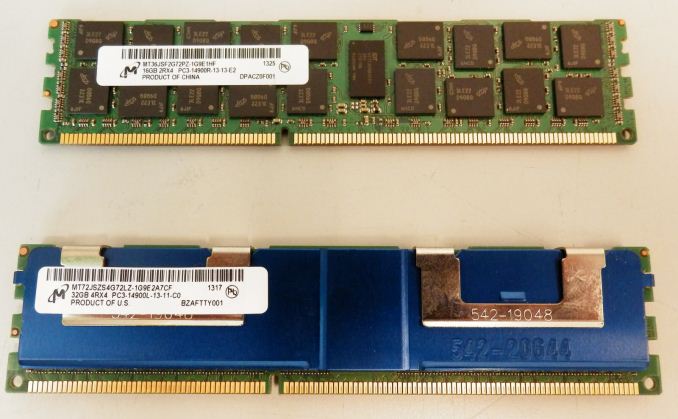Server Buying Decisions: Memory
by Johan De Gelas on December 19, 2013 10:00 AM EST- Posted in
- Enterprise
- Memory
- IT Computing
- Cloud Computing
- server

We reviewed several types of server memory back in August 2012. You still have the same three choices—LRDIMMs, RDIMMs, and UDIMMs—but the situation has significantly changed now. The introduction of the Ivy Bridge EP is one of those changes. The latest Intel Xeon has better support for LR-DIMMs and supports higher memory speeds (up to 1866 MHz).
But the biggest change is that the pricing difference between LRDIMMs and RDIMMs has shrunk a lot. Just a year ago, a 32GB LRDIMM cost $2000 and more, while a more "sensible" 16GB RDIMM costs around $300-$400. You paid about three times more per GB to get the highest capacity DIMMs in your servers. Many servers could benefit from more memory, but that kind of pricing made LRDIMMs only an option for IT projects where hardware costs were dwarfed by other costs like consulting and software licenses. Fifteen months in IT is like half a decade in other industries; just look at the table below.
| Memory type: |
Low voltage |
Ranks |
Price ($) Q4 2013 |
Price ($) perGB |
| 8GB RDIMM—1600 | yes | Dual | 153 | 19 |
| 16GB RDIMM—1600 | yes | Dual | 243 | 15 |
| 8GB RDIMM—1866 | no | Dual | 169 | 21 |
| 16GB RDIMM—1866 | no | Dual | 257 | 16 |
| 32GB RDIMM—1333 | yes | Quad | 808 | 25 |
| 32GB LRDIMM—1333 | yes | dual* | 822 | 26 |
| 32GB LRDIMM—1866 | no | dual* | 822 | 26 |
(*) Quad, but load of dual
If you need a refesher on UDIMMs, RDIMMs and LRDIMMs, check out our technical overview here. The price per GB of LRDIMMs is only 60% higher than that of the best RDIMMs. Quadrank 32GB RDIMMs used to be a lot cheaper than their load reduced competition and that difference is now negligible.










27 Comments
View All Comments
subflava - Thursday, December 19, 2013 - link
Great article...look forward to more enterprise/IT professional based articles from Anandtech in the future. This is very timely for me as my company is just about to pull the trigger on a server upgrade. Interesting stuff.JohanAnandtech - Friday, December 20, 2013 - link
Thanks for sharing! :-)DERSS - Friday, December 27, 2013 - link
You guys are seriously super-cool; thanks.wsaenotsock - Thursday, December 19, 2013 - link
costed?blaktron - Thursday, December 19, 2013 - link
Good article, although as an enterprise architect, I can tell you the one true benefit to LRDIMMS is in 2 and 4 socket vhost builds, because the double density RAM gives you the freedom to turn off NUMA spanning and still get near-ideal guest density.Almost nobody runs caching servers that big, although at almost double performance over a 256GB build (the 100k + concurrent user norm) its kind of attractive to run 2 of these per DC instead of 6 smaller ones (which would actually be the real world comparison with those kind of deltas).
mexell - Thursday, December 19, 2013 - link
Real-world pricing, at least in the enterprise context, is quite a bit off from your numbers. In my employer's price bracket, we regularily buy similar servers as your 24*16GB config for about the same price (13k€) - but including a 3 year subscription VMWare Enterprise license, which is about 6 to 7 k€ on its own. No one pays list price on that kind of hardware.JohanAnandtech - Friday, December 20, 2013 - link
Are you sure that there is not a big discount on the VMware license? And smaller enterprises will pay something close to the list price. I know that the typical discount is 10-20% for smaller quantities, not more.blaktron - Friday, December 20, 2013 - link
Depends on the country Johan. The partner channel managers get to decide discounts on partner orders (which he is describing). Also, the bundling discount doesn't happen everywhere, but I could buy that server for like $15k CDN.The VMware license cost seems out of this world to me too, because we license our hosts for anyone from 2500 to 5k CDN, depending on their agreement with VMware.
mexell - Saturday, December 21, 2013 - link
I don't really know where exactly the discount is applied, as the licenses are OEM and we don't get line-item pricing. In our market segment (large enterprise with Dell, medium-to-large with HP) we usually see at least 40% off on list prices, in some cases (networking equipment) up to 75%.VMWare, on the other hand, is especially rigid with their pricing structure. Two years ago, when we negotiated for a 100 host branch office deployment, they referred to their list pricing. For them, we are not even big enough to speak directly to us.
dstarr3 - Thursday, December 19, 2013 - link
Wow. With 768GB of memory, I bet you could run Crysis.